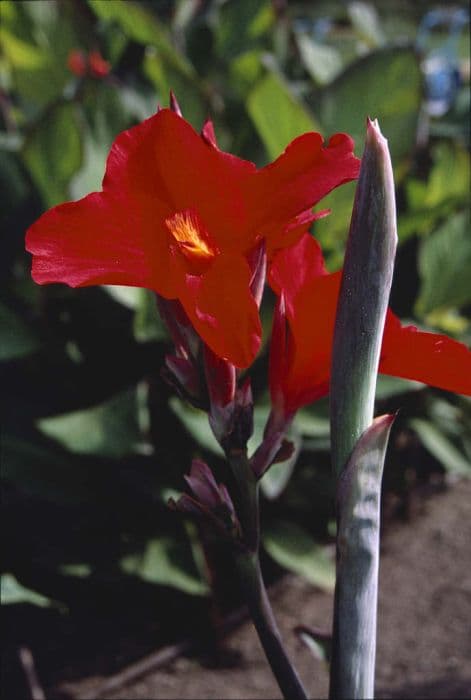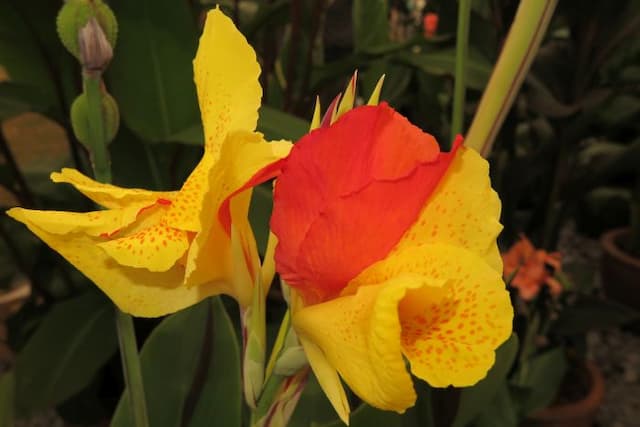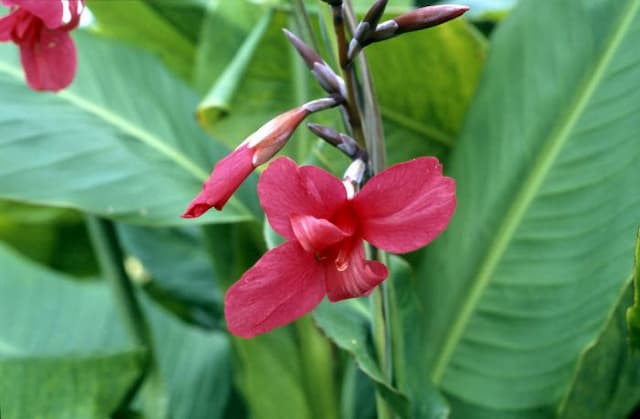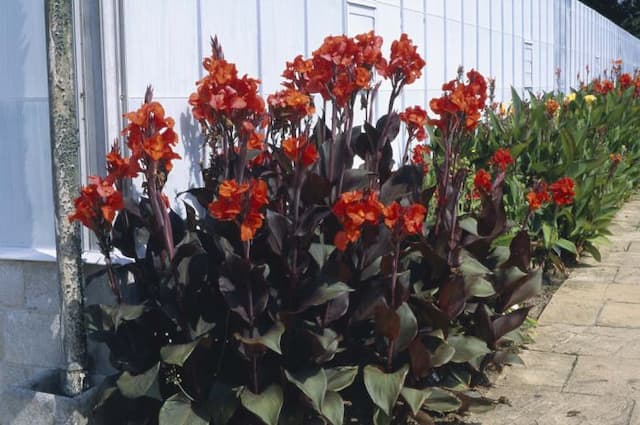Canna Lily Canna 'Happy Julia' (Cannasol Series)

ABOUT
The Canna 'Happy Julia' from the Cannasol Series is a vibrant and colorful plant, noted for its striking flowers and lush foliage. The plant displays an exotic charm, typical of cannas, with bright flowers that boast a warm, fiery hue of orange. These blossoms create a bold visual impact, especially when set against the backdrop of the plant's contrasting foliage. The leaves of Canna 'Happy Julia' are large and paddle-shaped, with a rich green color that may sometimes have hints of bronze or purple, depending on the light and growing conditions. The texture of the leaves is somewhat waxy and they have prominent veins. The overall appearance of Canna 'Happy Julia' is tropical and sumptuous, with the flowers characterized by a flared, funnel-like shape that is quite showy. They grow on tall stalks that rise prominently above the foliage. The striking look of the plant, with its combination of vivid flowers and substantial leaves, makes it a favorite for gardeners looking to add a touch of the tropics to their landscape.
About this plant
 Names
NamesFamily
Cannaceae
Synonyms
Canna Lily, Indian Shot, Canna
Common names
Canna 'Happy Julia'
 Toxicity
ToxicityTo humans
Canna lilies, including Canna 'Happy Julia', are not considered toxic to humans and typically do not cause any severe symptoms if ingested.
To pets
Canna lilies, including Canna 'Happy Julia', are also not considered toxic to pets. Ingestion may result in mild gastrointestinal discomfort, but serious toxicity is not expected.
 Characteristics
CharacteristicsLife cycle
Perennials
Foliage type
Deciduous
Color of leaves
Green
Flower color
Orange
Height
2-3 feet (60-90 cm)
Spread
1-2 feet (30-60 cm)
Plant type
Bulb
Hardiness zones
7-10
Native area
South America
Benefits
 General Benefits
General Benefits- Low maintenance: Canna 'Happy Julia' is easy to care for and does not require much attention once established.
- Vibrant blooms: It produces striking flowers with vivid colors that can add visual interest to any garden.
- Attracts pollinators: The flowers attract bees, butterflies, and hummingbirds, which helps pollinate your garden.
- Drought tolerant: Once established, this plant can withstand periods of low water, making it suitable for xeriscaping.
- Fast-growing: Canna 'Happy Julia' has a rapid growth rate, quickly filling in garden spaces.
- Long flowering season: It blooms from early summer until the first frost, providing extended garden interest.
- Ease of propagation: It can be easily propagated by dividing the rhizomes, allowing gardeners to expand their collection.
- Container gardening: This plant is suitable for potting, making it a great addition to patios and balconies.
- Tropical appearance: The large leaves and exotic flowers give a tropical feel to temperate gardens.
- Soil adaptability: It can adapt to a range of soil types, though it prefers rich, moist conditions.
 Medical Properties
Medical PropertiesThis plant is not used for medical purposes.
 Air-purifying Qualities
Air-purifying QualitiesThis plant is not specifically known for air purifying qualities.
 Other Uses
Other Uses- As an ornamental water plant: While Canna lilies grow well in moist soil, Canna 'Happy Julia' can also be grown at the water's edge or in a bog garden, adding an exotic look to water features.
- For starch production: Canna lilies, in general, have rhizomes that can be processed to produce arrowroot starch, which can be used in cooking and baking as a thickener.
- Natural dye source: The flowers and leaves of Canna 'Happy Julia' might be utilized for natural dyeing processes, providing colors for textiles and crafts.
- As a living fence: When planted in a row or a dense cluster, Canna 'Happy Julia' can create a colorful, living fence that provides privacy and wind protection.
- Educational plant: Canna 'Happy Julia' can be used for educational purposes in schools and botanical gardens to demonstrate plant biology and hybridization.
- In pond remediation: Canna lilies have the ability to uptake certain nutrients from water, thus potentially being used in the phytoremediation of pond ecosystems.
- Floral arrangements: The bold flowers and foliage of Canna 'Happy Julia' can be included in tropical-themed floral arrangements and bouquets.
- Mulching Material: After the growing season, the leaves and stems can be left on the ground to decompose and act as a mulch for winterizing garden beds.
- Creative crafting: Dried flowers and leaves of Canna 'Happy Julia' can be used in crafting projects, such as pressed flower art or natural confetti.
- Photography subject: The vivid colors and striking form of Canna 'Happy Julia' make it an excellent subject for photographers specializing in botanical and garden photography.
Interesting Facts
 Feng Shui
Feng ShuiThe canna lily is not used in Feng Shui practice.
 Zodiac Sign Compitability
Zodiac Sign CompitabilityThe canna lily is not used in astrology practice.
 Plant Symbolism
Plant Symbolism- Prosperity: Cannas, including the Canna 'Happy Julia', are often associated with wealth and abundance due to their lush and vibrant flowers.
- Change: The growth and transformation from a rhizome to a striking flower symbolizes change and adaptation.
- Fertility: Their prolific nature makes them a symbol of fertility and creativity.
- Fire: The bright, fiery colors of Canna flowers often represent passion, energy, and enthusiasm.
 Water
WaterCanna lilies, including 'Happy Julia', should be watered thoroughly when the top inch of soil begins to dry out, avoiding a set schedule but typically this equates to once every few days during active growth, depending on weather conditions. It's important to water deeply, which for potted plants could mean ensuring water runs out of the drainage holes, suggesting saturation of the soil. For garden-planted Canna lilies, each plant may require approximately half to one gallon of water at each watering occasion depending on soil type and climate. During hot, dry spells, watering frequency should increase, whereas during cooler, rainy periods, it will decrease. Overwintering or dormant plants require significantly less water, with only occasional watering to prevent the soil from completely drying out.
 Light
LightFor optimal growth, Canna lilies should be placed in an area that receives full sunlight for at least six to eight hours per day. They thrive in bright conditions that offer direct sun, as this encourages the best foliage color and flower production. Areas with partial shade are acceptable but may result in less vigorous growth and fewer blooms.
 Temperature
TemperatureCanna lilies prefer warm temperatures and perform best when the ambient temperature is between 60°F and 90°F. They can endure short periods of higher temperatures, but prolonged heat above 90°F can cause stress to the plants. Canna lilies should not be exposed to temperatures below 50°F, as cold temperatures can damage or kill the plant.
 Pruning
PruningPrune Canna lilies primarily to remove spent flowers and damaged or diseased leaves, which encourages the plant to produce more blooms and maintains its appearance. Pruning can be done throughout the growing season as needed. The best time for more extensive pruning is in late fall or early winter, after the plant has finished blooming and is preparing for dormancy.
 Cleaning
CleaningAs needed
 Soil
SoilCanna lilies thrive in a well-draining, rich, loamy soil with a pH between 6.0 and 6.5. A mix of garden soil, compost, and perlite or sand is ideal to ensure proper drainage and fertility.
 Repotting
RepottingCanna lilies should be repotted every 2 to 3 years to refresh the soil and provide them with more space to grow.
 Humidity & Misting
Humidity & MistingCannas prefer high humidity levels but are quite adaptable and can tolerate lower humidity levels without significant issues.
 Suitable locations
Suitable locationsIndoor
Place in bright, indirect light and keep soil moist in a warm room.
Outdoor
Plant in full sun, in rich soil, water frequently, and provide mulch.
Hardiness zone
7-11 USDA
 Life cycle
Life cycleCanna 'Happy Julia' begins its life as a rhizome, which, when planted in warm spring soil, will sprout into green shoots. As temperature increases, it grows rapidly, producing large paddle-shaped leaves. Throughout the summer, the plant blooms, displaying vibrant orange flowers that attract pollinators such as bees and hummingbirds. Once pollinated, the flowers may develop seed pods, but cultivars like 'Happy Julia' are often sterile and propagated primarily by division of rhizomes. As the weather cools in fall, the plant's growth slows down, and it eventually enters dormancy in winter, with foliage dying back. To ensure the plant's survival, the rhizomes can be overwintered indoors in colder climates and replanted the following spring.
 Propogation
PropogationPropogation time
Spring to Summer
Propogation: Canna 'Happy Julia', a member of the Cannasol Series, is typically propagated through the division of rhizomes. The best time for this activity is in the spring when the plants are coming out of dormancy and before they start their rapid spring growth. To propagate, carefully unearth the rhizomes and use a sharp, clean knife to divide them, ensuring each section has at least one eye, which is a growth point. The divided rhizomes can then be replanted immediately, about 3 to 4 inches (approximately 7.6 to 10.2 centimeters) deep in the soil, allowing for new canna plants to grow and establish themselves. This method is favored for its simplicity and effectiveness in producing true to type offspring, maintaining the vibrant colors and characteristics of the 'Happy Julia' canna.









